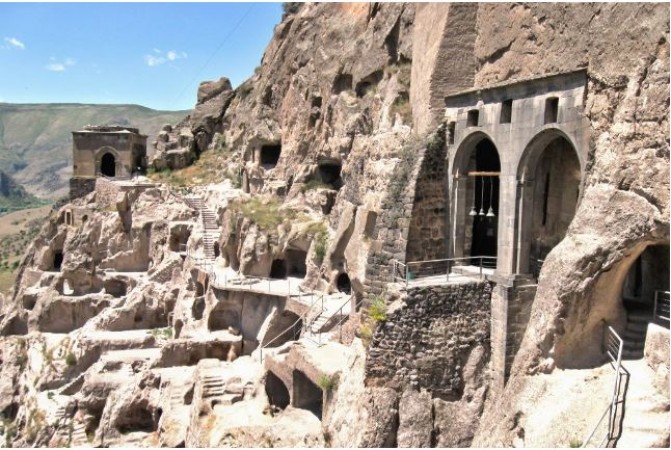
The Vardzia Cave City, located in southern Georgia, is an architectural wonder that stands as a testament to the ingenuity and resilience of the ancient Georgians. Carved into the rugged cliffs of the Erusheti Mountain, this unique complex of caves dates back to the 12th century and has a history as fascinating as its breathtaking landscape.
Vardzia was established during the reign of Queen Tamar, one of Georgia's most remarkable rulers. It was conceived as a strategic stronghold and a religious center, intended to protect the kingdom from invasions by Mongols and other neighboring forces. Construction began around 1185 AD, and the city was continuously expanded over the centuries. In its prime, Vardzia stretched over 13 levels and contained around 3,000 caves.
Also Read: Adventure in New Zealand's South Island: Queenstown, Milford Sound, and Glacier Country
The architectural brilliance of Vardzia lies in its harmonious integration with the natural landscape. The complex comprises numerous caves, interconnected with a network of tunnels, stairways, and passages. These caves served various purposes, including residential areas, churches, storerooms, wineries, and even defensive structures. Many of the caves were adorned with elaborate frescoes and intricate carvings, reflecting the artistry of the medieval Georgian culture.
The city's upper levels mainly consisted of religious spaces, featuring numerous small chapels, the Church of the Dormition, and the Church of the Assumption, which is the largest and most prominent. The Church of the Dormition is particularly remarkable, with its well-preserved frescoes depicting biblical scenes and important religious figures.
Also Read: The Serenity of Seychelles: Secluded Beaches and Island Adventures
Vardzia's strategic location and complex design also made it a sanctuary for the Georgian people during turbulent times. In the face of invasions, the inhabitants of nearby towns and villages sought refuge within the safety of Vardzia's walls. The network of tunnels and hidden passages allowed the people to escape unnoticed and evade capture during enemy attacks.
Apart from its military significance, Vardzia served as a major spiritual center during the medieval period. It attracted scholars, theologians, and monks, making it a thriving hub of religious activities. The city housed a significant number of monks, with a structured monastic community dedicated to religious study, prayer, and meditation.
Also Read: Palma de Mallorca: The Enchanting Capital of Spain's Balearic Islands
Despite its strength and significance, Vardzia's prominence waned over time. In the 16th century, the region fell under Persian control, and the city suffered significant damage during an earthquake in 1283 and an invasion in the 15th century. With the decline of the Silk Road trade routes, Vardzia's strategic importance diminished, leading to its gradual abandonment.
The city's existence was largely forgotten, and it remained hidden for centuries until it was rediscovered by Georgian explorers in the late 19th century. Subsequent archaeological excavations have revealed the grandeur of this once-thriving cave city.
Recognizing the historical and cultural significance of Vardzia, it was designated as a UNESCO World Heritage Site in 1996. The Georgian government, along with international organizations, has taken significant steps to preserve and protect this architectural treasure. Restoration efforts have been carried out to conserve the delicate frescoes and stabilize the caves to prevent further deterioration.
Also Read: Hessen: Exploring Germany's Vibrant Heartland
Vardzia is open to visitors from around the world, attracting history enthusiasts, archaeologists, and curious travelers. The journey to Vardzia is an adventure in itself, as it takes visitors through picturesque landscapes, with the Erusheti Mountain providing a stunning backdrop.
Exploring the cave city is like stepping back in time, as visitors wander through the narrow passageways and explore the well-preserved chapels and dwellings. The experience offers a glimpse into the daily lives of the medieval inhabitants and the cultural and religious practices that thrived in the region.
Also Read: Saarland: A Hidden Gem of Germany
Vardzia Cave City stands as a remarkable example of human ingenuity and determination. Its unique architectural design, religious significance, and historical context make it a treasure of Georgia and a captivating site for all who visit. Preserving such cultural heritage sites is essential to ensure that future generations can continue to marvel at and learn from the achievements of our ancestors. As we explore the fascinating history of Vardzia, we also recognize the importance of safeguarding and cherishing the rich legacy of humanity's past.
Also Read: Madrid: Vibrant Metropolis
Island Hopping in the Azores, Portugal: Unveiling the Enchanting Treasures of the Atlantic
Exploring the Croatian Coastline: Sailing the Adriatic and Visiting Dubrovnik